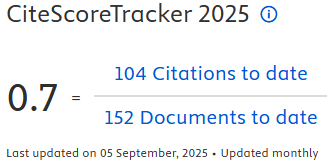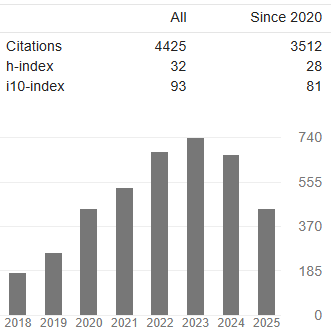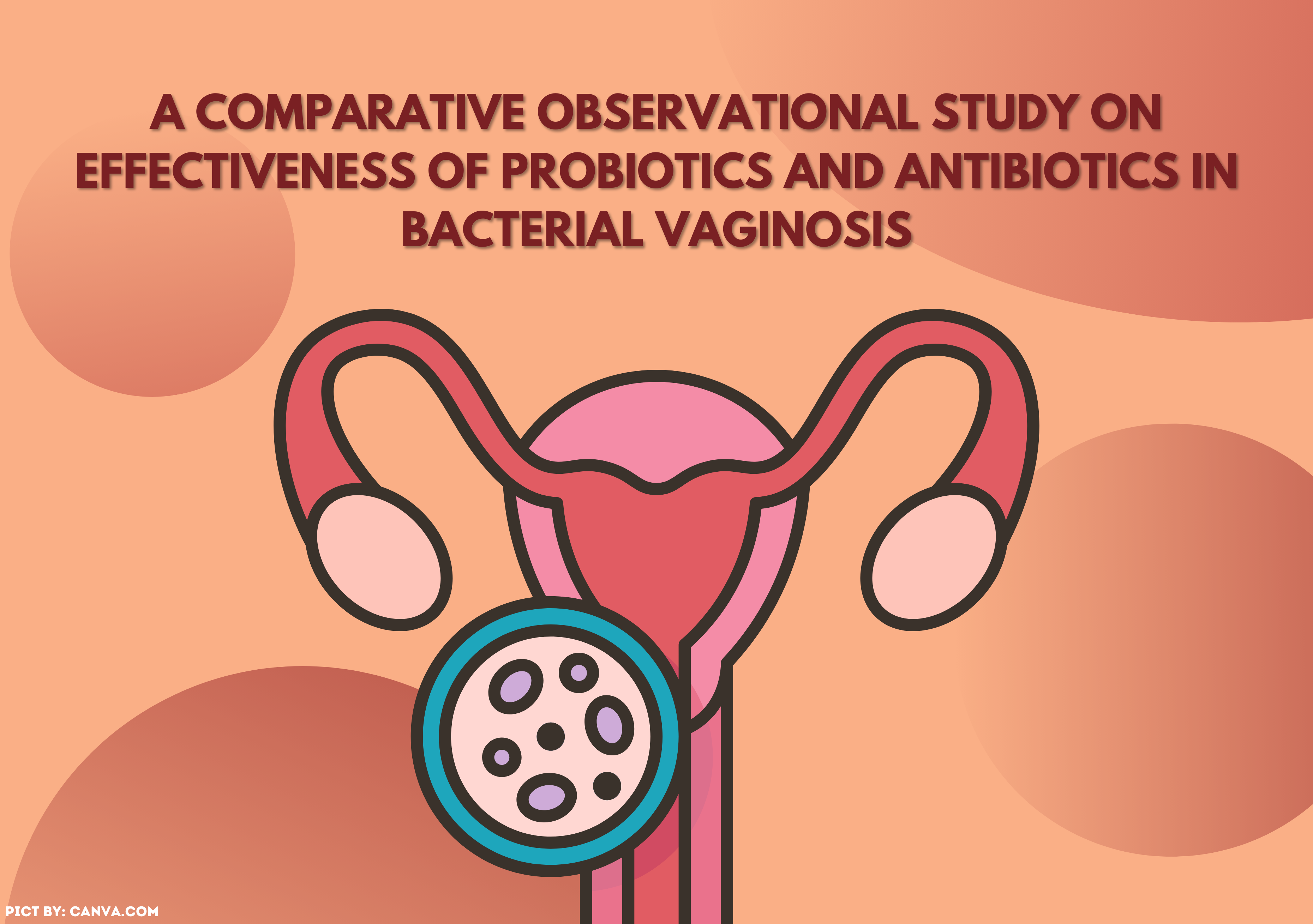SENSITIVITY AND SPECIFICITY OF A NEW TOOL FOR EARLY DETECTION OF RISK FACTORS FOR NON COMMUNICABLE DISEASES IN URBAN WORKERS

Introduction: Non communicable diseases (NCDs) have an impact on health, economy, and quality of life, and can reduce worker productivity. Approximately 41 million people die from NCDs every year, accounting for 74% of deaths worldwide. The Deteksi Dini Faktor Risiko Gizi dan Kesehatan (DDR-GizKes) is instrument designed for the early detection of nutritional and health risk factors related to NCDs that affect the productivity of urban workers . A screening test is essential part of this newly developed tool. Aims: This study aims to test the sensitivity and specificity of the DDR-GizKes instrument for detecting NCDs in urban workers. Methods: This study used a descriptive observational design with a cross-sectional approach. The population consisted of 227 teachers and staff in high schools in Yogyakarta who were selected using a cluster random sampling technique. Hypertension was used as the gold standard for the screening test. Results: The nutritional risk factor test had a sensitivity of 15.8% and a specificity of 94.2%. The positive predictive value (PPV) for the nutritional risk factor was 16.7% and the negative predictive value (NPV) was 93.8%. Meanwhile, the health risk factor test had a sensitivity of 15.8% and a specificity of 86.4%. The PPV for the health risk factor was 7.89% and the NPV was 93.3%. Conclusion: The DDR-GizKes instrument had low sensitivity but high specificity. Further research is necessary to establish the scoring system of the DDR-GizKes instrument in populations with a high prevalence of NCDs using a larger sample size.
Bujang, M. A., & Adnan, T. H. (2016). Requirements for minimum sample size for sensitivity and specificity analysis. Journal of Clinical and Diagnostic Research, 10(10), YE01–YE06. https://doi.org/10.7860/JCDR/2016/18129.8744
Caraballo, C., Wang, B., Angraal, S., Zhao, Y., Zheng, X., Lu, J., & Wu, C. (2021). Association of age and blood pressure among 3.3 million adults: Insights from China PEACE million persons project. Journal of Hypertension, 39(6), 1143–1154. https://doi.org/10.1097/HJH.0000000000002793
Cheng, W., Du, Y., Zhang, Q., Wang, X., He, C., He, J., Jing, F., Ren, H., Guo, M., Tian, J., & Xu, Z. (2022). Age-related changes in the risk of high blood pressure. Frontiers in Cardiovascular Medicine, 9(September), 1–10. https://doi.org/10.3389/fcvm.2022.939103
Firmansyah, Y., Ernawati, E., & Prawiro, E. L. (2020). Sistem Skoring Untuk Memprediksi Kejadian Hipertensi Pada Usia Produktif Di Kota Medan (Preliminary Study). Jurnal Muara Sains, Teknologi, Kedokteran Dan Ilmu Kesehatan, 4(1), 55. https://doi.org/10.24912/jmstkik.v4i1.6013
Fuchs, F. D., & Whelton, P. K. (2020). High Blood Pressure and Cardiovascular Disease. Hypertension, 75(2), 285–292. https://doi.org/10.1161/HYPERTENSIONAHA.119.14240
Gibney, M. J., Barr, S. I., Bellisle, F., Drewnowski, A., Fagt, S., Livingstone, B., Masset, G., Moreiras, G. V., Moreno, L. A., Smith, J., Vieux, F., Thielecke, F., & Hopkins, S. (2018). Breakfast in human nutrition: The international breakfast research initiative. Nutrients, 10(5), 1–12. https://doi.org/10.3390/nu10050559
Gogtay, N. J., & Thatte, U. M. (2017). Statistical evaluation of diagnostic tests (part 1): Sensitivity, specificity, positive and negative predictive values. Journal of Association of Physicians of India, 65(JUNE), 80–84.
Gupta, A., S, S., Aravindakshan, R., & Kekkar, R. (2017). A Pilot Retrospective Study Validating Noncommunicable Disease Risk Assessment Score (AMNRAS). International Journal of Preventive Medicine, 8. https://doi.org/10.1016/j.ihj.2018.02.003
Gupta, R., & Xavier, D. (2018). Hypertension: The most important non communicable disease risk factor in India. Indian Heart Journal, 70(4), 565–572. https://doi.org/10.1016/j.ihj.2018.02.003
H, M. S. S., Nisthar, S., & Nufile, A. A. M. (2021). An analysis of the relationship between the productivity and the non-communicable diseases. 14(3), 92–111.
Hajian-Tilaki, K. (2014). Sample size estimation in diagnostic test studies of biomedical informatics. Journal of Biomedical Informatics, 48, 193–204. https://doi.org/10.1016/j.jbi.2014.02.013
Health Service of Special Region of Yogyakarta. (2022). Health Profile of Special Region of Yogyakarta 2021. In Health Service of Special Region of Yogyakarta.
Idris, I. B., Azit, N. A., Abdul Ghani, S. R., Syed Nor, S. F., & Mohammed Nawi, A. (2021). A systematic review on noncommunicable diseases among working women. Industrial Health, 59(3), 146–160. https://doi.org/10.2486/indhealth.2020-0204
Ismail, N. W., & Sivadas, S. (2020). Urban health and the prevalence of non-communicable diseases in Malaysia. Malaysian Journal of Medicine and Health Sciences, 16(2), 3–9.
Jung, M. H., Yi, S. W., An, S. J., & Yi, J. J. (2019). Age-specific associations between systolic blood pressure and cardiovascular mortality. Heart, 105(14), 1070–1077. https://doi.org/10.1136/heartjnl-2019-314697
Kazibwe, J., Tran, P. B., & Annerstedt, K. S. (2021). The household financial burden of non-communicable diseases in low- and middle-income countries: a systematic review. Health Research Policy and Systems, 19(1), 1–15. https://doi.org/10.1186/s12961-021-00732-y
Kuruvilla, A., Mishra, S., & Ghosh, K. (2023). Prevalence and risk factors associated with non-communicable diseases among employees in a university setting: A cross-sectional study. Clinical Epidemiology and Global Health, 21(March), 101282. https://doi.org/10.1016/j.cegh.2023.101282
Maxim, L. D., Niebo, R., & Utell, M. J. (2014). Screening tests: A review with examples. Inhalation Toxicology, 26(13), 811–828. https://doi.org/10.3109/08958378.2014.955932
Ministry of Education Culture Research and Technology of the Republic of Indonesia. (2023). Basic Education Data. Ministry of Education Culture Research and Technology of the Republic of Indonesia. https://dapo.kemdikbud.go.id/progres-sma/1/040000
Ministry of Health. (2019). Baseline Health Research 2018 (Riskesdas 2018). Ministry of Health Republic of Indonesia.
Mularum, S. N., Kusnanto, H., & Istiono, W. (2018). The Precision of Screening Questionnaires for Diabetes Mellitus Type 2 and Hypertension Compared with the Gold Standard in Primary Care. Review of Primary Care Practice and Education (Kajian Praktik Dan Pendidikan Layanan Primer), 1(2), 75. https://doi.org/10.22146/rpcpe.36219
Murad, M. H., Lin, L., Chu, H., Hasan, B., Alsibai, R. A., Abbas, A. S., Mustafa, R. A., & Wang, Z. (2023). The association of sensitivity and specificity with disease prevalence: analysis of 6909 studies of diagnostic test accuracy. CMAJ. Canadian Medical Association Journal, 195(27), E925–E931. https://doi.org/10.1503/cmaj.221802
Nai, H. M. E., Estri, A. K., & Widianti, C. R. (2023). Developing a New Tool for Early Detection of the Nutritional and Health Risk Factors of Urban Workers' Productivity. Kesmas, 18(1), 41–49. https://doi.org/10.21109/kesmas.v18i1.6359
Nugraeni, T. A. E., Nai, H. M. E., & Maria, R. F. (2023). Hubungan Pola Konsumsi Makanan Cepat Saji dan Frekuensi Pemesanan Makanan Online dengan Obesitas Sentral pada Siswa SMA di Yogyakarta. Amerta Nutrition, 7(3), 413–420. https://doi.org/10.20473/amnt.v7i3.2023.413-420
Nurpratiwi, Hatmalyakin, D., Amaludin, M., Hidayat, U. R., Akbar, A., Arisandi, D., & Alfikrie, F. (2023). Early Detection of Hypertension (EDH) Skoring dalam Memprediksi Kejadian Hipertensi pada Usia Produktif. Wiraraja Medika : Jurnal Kesehatan, 13(1), 16–25. https://doi.org/10.24929/fik.v13i1.2503
Rijal, A., Adhikari, T. B., Khan, J. A. M., & Berg-Beckhoff, G. (2019). Correction: The economic impact of noncommunicable diseases among households in South Asia and their coping strategy: A systematic review (PLoS ONE (2018) 13:11 (e0205745) DOI: 10.1371/journal.pone.0205745). PLoS ONE, 14(1), 1–23. https://doi.org/10.1371/journal.pone.0211588
Swift, A., Heale, R., & Twycross, A. (2020). What are sensitivity and specificity? Evidence-Based Nursing, 23(1), 2–5. https://doi.org/10.1136/ebnurs-2019-103225
Tolonen, H., Reinikainen, J., Zhou, Z., Härkänen, T., Männistö, S., Jousilahti, P., Paalanen, L., Lundqvist, A., & Laatikainen, T. (2023). Development of non-communicable disease risk factors in Finland: projections up to 2040. Scandinavian Journal of Public Health, 51(8), 1231–1238. https://doi.org/10.1177/14034948221110025
Trevethan, R. (2017). Sensitivity, Specificity, and Predictive Values: Foundations, Pliabilities, and Pitfalls in Research and Practice. Frontiers in Public Health, 5(November), 1–7. https://doi.org/10.3389/fpubh.2017.00307
Wicherski, J., Schlesinger, S., & Fischer, F. (2021). Observational Longitudinal Studies. Nutrients, 13(66492), 272. https://doi.org/10.3390/nu13010272
World Health Organization. (2019). Health, Decent Work and the Economy. Policy Brief, 18.
World Health Organization. (2023a). Hypertension. World Health Organization.
World Health Organization. (2023b). Noncommunicable diseases.
ZatoÅ„ska, K., Psikus, P., Basiak-RasaÅ‚a, A., StÄ™pnicka, Z., GaweÅ‚-Dabrowska, D., WoÅ‚yniec, M., Gibka, J., Szuba, A., & PoÅ‚tyn-Zaradna, K. (2021). Obesity and chosen non-communicable diseases in pure poland cohort study. International Journal of Environmental Research and Public Health, 18(5), 1–10. https://doi.org/10.3390/ijerph18052701
Copyright (c) 2024 The Indonesian Journal of Public Health

This work is licensed under a Creative Commons Attribution-NonCommercial-ShareAlike 4.0 International License.
- The authors agree to transfer the transfer copyright of the article to The Indonesian Journal of Public Health effective if and when the paper is accepted for publication.
- Authors and other parties are bound to the Creative Commons Attribution-NonCommercial-ShareAlike 4.0 International License for the published articles, legal formal aspect of journal publication accessibility refers to Creative Commons Attribution-NonCommercial-ShareAlike 4.0 International License (CC BY-NC-SA), implies that:
- Attribution ” You must give appropriate credit, provide a link to the license, and indicate if changes were made. You may do so in any reasonable manner, but not in any way that suggests the licensor endorses you or your use.
- NonCommercial ” You may not use the material for commercial purposes.
- ShareAlike ” If you remix, transform, or build upon the material, you must distribute your contributions under the same license as the original.































